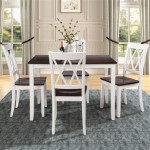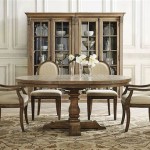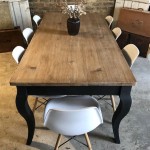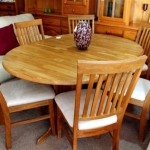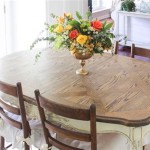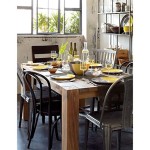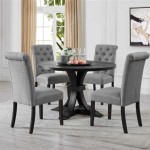Glass For Top Of Dining Table: A Comprehensive Guide
A glass tabletop can significantly enhance the aesthetics and functionality of a dining table. It provides a sleek, modern surface, protects the underlying table from damage, and is generally easier to clean than many other materials. Choosing the right glass for a dining table top, however, requires careful consideration of various factors, including glass type, thickness, edge finishing, and safety considerations. This article will provide a comprehensive overview of these aspects, guiding individuals towards informed purchasing decisions.
Types of Glass Suitable for Dining Tables
The primary considerations when selecting glass for a dining table top are safety and durability. Different glass types offer varying degrees of these qualities. The most common options are tempered glass, annealed glass, and laminated glass. Each possesses distinct properties that make them suitable for specific applications and preferences.
Tempered Glass: Tempered glass, also known as safety glass, undergoes a heat treatment process that significantly increases its strength. During this process, the glass is heated to a high temperature and then rapidly cooled. This creates a compression layer on the surface of the glass, making it much more resistant to impacts and stress. In the event of breakage, tempered glass shatters into small, relatively harmless pieces, reducing the risk of serious injury. This characteristic makes it the preferred choice for dining table tops, especially in households with children or pets.
The increased strength of tempered glass allows for a relatively thinner profile compared to annealed glass when used in similar applications. This can contribute to a more streamlined and modern aesthetic for the dining table. From a functional perspective, tempered glass provides a visually clear and scratch-resistant surface, ideal for dining purposes.
Annealed Glass: Annealed glass is the standard type of glass used in windows and many other applications. It is formed through a process of slowly cooling molten glass to relieve internal stresses. While less expensive than tempered glass, annealed glass is also significantly weaker. When broken, it shatters into large, sharp shards, posing a considerable safety hazard. While annealed glass can be used as a dining table top, it is generally not recommended due to the safety concerns. If annealed glass is chosen, a thicker gauge will be necessary and safety protocols are an absolute must.
The primary benefit of annealed glass comes down to cost. Its lower price point compared to other forms of strengthened glass can make it an initially attractive option. However, the potential risks associated with its susceptibility to shattering into dangerous shards often outweigh the cost savings, particularly for households with children or pets. In addition, annealed glass tends to scratch more easily than tempered glass, impacting its long-term appearance.
Laminated Glass: Laminated glass consists of two or more layers of glass bonded together with a plastic interlayer, typically polyvinyl butyral (PVB). This interlayer holds the glass fragments together in the event of breakage, preventing them from scattering and minimizing the risk of injury. While laminated glass may not be as strong as tempered glass in terms of point impact resistance, it offers excellent safety characteristics and can also provide soundproofing benefits.
Laminated glass offers an extra layer of safety and impact resistance, surpassing even tempered glass in certain scenarios. The PVB interlayer not only contains fragments upon breakage but also absorbs some impact, reducing the severity of damage. This type of glass is sometimes preferred in commercial settings or where particularly high impact resistance is desirable. The enhanced soundproofing qualities may be a benefit in open-plan living spaces.
Considerations for Glass Thickness and Edge Finishing
Beyond the type of glass, the thickness and edge finishing are critical factors influencing the durability, safety, and overall appearance of a glass dining table top. Proper selection ensures both structural integrity and aesthetic appeal.
Glass Thickness: The appropriate thickness of the glass depends on the size of the table, the type of support it receives, and the intended use. A larger table requires thicker glass to prevent sagging or breakage. Generally, for a typical dining table, glass thicknesses range from ¼ inch (6mm) to ¾ inch (19mm). For smaller tables or tables with full support underneath, ¼ inch or ⅜ inch (10mm) glass may be sufficient. For larger tables or those with only edge supports, ½ inch (12mm) or thicker glass is recommended to ensure adequate strength and stability.
The thickness of the glass is directly related to its ability to withstand loads and stresses. A thicker glass panel will inherently be more rigid and less prone to deflection or bending under weight. This is especially important for larger tabletops or tables that are frequently subjected to heavy objects or significant pressure. Choosing an insufficient thickness may lead to cracking or even complete failure of the glass, creating a hazardous situation. It is always advisable to err on the side of caution and select a glass thickness that provides an adequate margin of safety.
Edge Finishing: The edge finish of the glass affects both its appearance and safety. Sharp edges are a safety hazard and can easily chip or break. Common edge finishing options include polished edges, beveled edges, and eased edges. Polished edges are smooth and rounded, offering a refined look and minimizing the risk of cuts. Beveled edges are angled, creating a decorative effect and enhancing the table's aesthetic appeal. Eased edges are slightly rounded, providing a comfortable and safe surface. For dining tables, polished or beveled edges are generally preferred due to their combination of safety and aesthetic appeal.
The choice of edge finishing can drastically alter the overall style of the dining table. A polished edge provides a simple and clean look, blending seamlessly with most modern decor schemes. A beveled edge adds a touch of elegance and sophistication, reflecting light in a subtle yet eye-catching way. An eased edge is a cost-effective option which provides a good safety level. The selection of edge finishing should complement the design of the table base and the surrounding dining room environment.
Safety and Maintenance Considerations
Ensuring the safety of a glass dining table top is paramount. Selecting the appropriate type and thickness of glass are crucial steps, but additional safety measures and proper maintenance practices contribute to a safe and long-lasting investment.
Safety Measures: Beyond choosing tempered or laminated glass, consider applying a safety film to the underside of the glass. This film provides an extra layer of protection in case of breakage, holding the glass fragments together and further minimizing the risk of injury. This is especially important for tables used in high-traffic areas or households with young children. Corner protectors can also be used to cushion sharp edges, providing additional safety in case of accidental bumps or collisions.
The addition of safety film is a relatively inexpensive way to significantly enhance the safety of a glass tabletop. It acts as a secondary barrier, preventing shards from scattering even if the glass breaks. This film is typically transparent and does not noticeably alter the appearance of the glass. Implementing this precaution is particularly recommended for tables with annealed glass, as it mitigates some of the inherent risks associated with this type of glass. For households with young children, safety film is a highly advisable investment.
Maintenance: Glass tabletops are generally easy to clean and maintain. Regular cleaning with a mild glass cleaner and a soft cloth will keep the surface looking pristine. Avoid using abrasive cleaners or scouring pads, as these can scratch the glass. Protect the glass from extreme temperature changes, as sudden temperature fluctuations can cause stress and potentially lead to cracking. When placing hot dishes on the table, use coasters or trivets to prevent thermal shock. With proper care, a glass dining table top can maintain its beauty and functionality for many years.
Regular cleaning is essential not only for maintaining the appearance of the glass but also for preventing the buildup of dirt, grime, and food residue that can etch or stain the surface over time. Promptly addressing spills and stains is crucial to prevent permanent damage. When cleaning, it is important to use a glass cleaner specifically formulated for glass surfaces. Avoid using general-purpose cleaning products, as they may contain harsh chemicals that can damage the glass. A soft microfiber cloth is ideal for wiping the surface, as it will not scratch or leave behind lint. Taking these simple precautions will ensure that the glass dining table top remains in excellent condition for years to come.

Acme Furniture Osias Dining Table With Glass Top Ossias Tables

Diy Glasstop Dining Table Tutorial House Of Jade Interiors

Stainless Steel Glass Top Modern Dining Table

Pros Cons Of Glass Top Dining Tables Academy

Glass Dining Table Top 96 Rectangular Sunpan Trading Importing Inc

Dining Table Legs Glass Top Base For Beech Wood Perfect Diy Tables And Furniture Projects Etsy Canada

Upgrade Your Space With Our High Quality Glass Top Table X Shape Espresso Base Payless Furniture

Rectangular Glass Top Dining Table 2061 By Esf Furniture Mig

Homcom Square Kitchen Table For 2 4 People Dining With Glass Top And Steel Legs Room Black Aosom Canada

Canadel Downtown Glass Top Dining Table 4060 With Dp Base Valley Ridge Furniture

